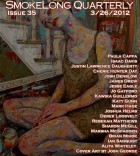My favorite flashes are those that leave me with more questions than answers, which is what your flash did. Also, you completely hooked me with the brilliant first line: “We find the calf under a pile of busted-up sinks.” Was this line the starting point for you or did it come to you later?
This piece began with a prompt from The First Line, which is this great journal that publishes stories all beginning with the same opening sentence. In this case, it was “There are a few things you need to know before we start.” My free write began there and resulted in a monologue where Chuck outlines how he and Pearlman make a living. But the story didn’t begin until they found the calf, so my next draft began with: “We find the calf under a pile of busted-up office equipment.” That felt clunky, so I kept revising until I found a sharper word/image combination.
When I read submissions for my guest week, I read them blind so I had no idea that you were a woman writing this story. In fact, I assumed you were a man. This tells me you captured these two men entirely convincingly. Not that women can’t write men and vice versa, but it simply never crossed my mind while reading that you were a woman. What do you think about that and why did you choose to write this piece from a man’s point of view?
When I start a story, I never know who or what will emerge. For me, it’s more exciting to experience the scene as a character does—by reacting to a situation—and simply allowing the fictional world to spill out as I go. The ratio of my main characters splits almost equally between men and women, which I suppose makes sense, though in this story, the voice felt male from the start. I imagine that’s because a woman living in this kind of world would have a vastly different experience.
I fell hard for Pearlman and Chuck and the post-apocalyptic world they inhabit. Is this part of a longer work? Could it be? Please say yes!
Unfortunately, it isn’t! However, for the past few years, I’ve been working on a pre-apocalyptic novel about a young girl. It’s a completely different tale, but I think the basic motifs spilled into this story.
Tell me about the crowd. They seem to be one part Occupy the Apocalypse and one part zombie. Who are they and why are they so furious out in those streets?
Occupy the Apocalypse—I love that! Truthfully, I don’t know who they are, but I was okay with that since some stories should maintain a certain amount of mystery. When the line “In the streets outside, the crowds seethe and scream” popped from the initial free write, I sensed that’s all I needed—especially for flash fiction, where you have limited space to sketch out a world. In this case, the less I knew about them, the more sinister and dangerous they became, which added to the story’s mood.
When I was a teenager I read a post-apocalyptic book, Mockingbird by Walter Tevis, in which people had lost the ability to read over time. Books were completely lost to them and society had broken down. Then one of the characters finds a buried mall or something of the sort with a bookstore and books. He teaches himself to read or something of the sort and his world begins to blossom. I am probably remembering the details incorrectly, but it was something along those lines. Anyway, I was intrigued that Pearlman held some knowledge that was lost to others: language. Why do you think Pearlman is the holder of the knowledge?
It probably emerged from his name. I liked the idea of a “man of pearls”—someone who still preserved a few scraps of wisdom after all else is lost. It’s definitely a key element of classics like Fahrenheit 451, where characters strive to memorize books in order to keep them alive. But in my story, I found that Pearlman was an ambivalent knowledge keeper; while he could recall some essential tenets, he’d either lost a sense of their meaning or perverted it. And while Chuck had forgotten a lot more (including personal things, like his own family), he still remembered the emotional and intellectual import of keeping language and history alive.
Now that I know who you are, I’ve checked out your incredible visual art. What part does your being a visual artist play in also being a creative writer?
Visual art largely came first, so as I began to write fiction, I borrowed heavily from my drawing process. For example, I always start a story by hand. I like the looseness of it, the messiness, and I write as quickly as possible without worrying about logic or end result. A handwritten draft feels like a thumbnail sketch, where the only goal is to find the basic shape of a thing. I then pick out what feels right and start over. This is more or less the way it works with a drawing or painting; I sketch an idea, draw, then trace, redraw, and retrace until I strike the right composition, details, and line quality.
A lot of my stories—including this one—are also inspired by visual art. A few months ago, I went to a gallery show called “Au,” where a group of invited artists were given a gold ingot with which to create something. One of them made a golden calf. I knew the calf would appear in a story, and I figured the ingot might make it in as well, though at that point I had no idea how. In that sense, my process of writing is the opposite of visual art: with a drawing, I generally have a mental image of what I’m striving to create, whereas with fiction, I don’t know what the story will be until it rambles onto the page.



 The core workshop of SmokeLong Fitness is all in writing, so you can take part from anywhere at anytime. We are excited about creating a supportive, consistent and structured environment for flash writers to work on their craft in a community. We are thrilled and proud to say that our workshop participants have won, placed, or been listed in every major flash competition. Community works.
The core workshop of SmokeLong Fitness is all in writing, so you can take part from anywhere at anytime. We are excited about creating a supportive, consistent and structured environment for flash writers to work on their craft in a community. We are thrilled and proud to say that our workshop participants have won, placed, or been listed in every major flash competition. Community works.